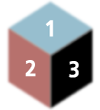Children's vision
How does your child’s vision develop?
Explanations and some tips.
How does vision form?
Vision is formed through a complex process involving several parts of the visual system, including the eye and brain. When an object is perceived, light enters the eye through the pupil. It focuses on the retina, where visual receptors (photoreceptors called cones and rods) transform light into electrical impulses that are then transmitted to the brain through the optic nerve. The brain then analyses this visual information to form a coherent image.
How does children’s vision develop?

Birth: Near and far vision is blurred (5% of adult vision) and in black and white. Newborns mostly see highly contrasting objects up close, and their field of vision is still very small.

2-3 months old: An infant can focus his vision, following his mother’s face and then objects; he responds to smiles. The infant develops colour vision, perceiving and differentiating colours.

3-9 months old: The two eyes learn to coordinate, allowing the baby to see 3D surfaces. He begins to perceive details.

1 year old: Vision is still blurred, estimated at 30-40% of adult vision. The child’s hand-eye coordination improves.

4 years old: The retina is fully developed, but vision is still only about 60%.

7 years old: Vision corresponds to that of an adult (100%), but its “fine” development still continues.
Visual development depends on the provision of adequate visual stimulation, and can be affected by factors such as refractive abnormalities, eye diseases and neurovisual disorders. Babies, for example, need to be exposed to a wide range of objects and colours at different distances to stimulate their vision. Viewing objects up close also allows them to develop their short-distance visual acuity. Older children should be encouraged to use their close-up vision for longer periods through activities such as reading or drawing.
It is important to regularly monitor the development of the child’s vision and take him to an eye specialist if problems occur. Visual disorders such as myopia, hyperopia and strabismus can affect a child’s visual development, and must be diagnosed and corrected in a timely manner to ensure optimal visual development. A family history of eye conditions may also play a role.
Choosing children’s glasses
When the baby or child has a visual disorder, the ophthalmologist can then perform an ophthalmological examination and extend a prescription for glasses. Before going to the optician, here are some tips to choose the right frame.
The child’s “world” is in front of him, but also often above: he looks up to see you, for example. In addition, he moves much more than an adult! It is therefore important to choose a suitable optical correction.
Three elements are essential in the choice of frames:
- Large corrective lenses so that the child always sees through them, even if he looks up.
- Good support behind the ears.
- Good support on the nose so that the glasses do not slip.
Beware of the sun!
The lens of the eye, known as the crystalline, is transparent until the age of 9 and does not protect the eye from the sun’s rays. Children must therefore wear sunglasses if they have a lot of exposure to the sun, at the beach or in the mountains for example.
